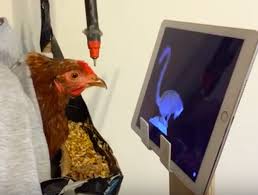There's A Fox In The Chicken Coop
Olivia Fox & Strawberry
 You may have seen the viral video of Strawberry, the chicken that watches TV. She's our guest along with her guardian, Olivia Fox. According to Olivia, TV isn't the only bad habit this chicken has. Apparently Strawberry enjoys some of the sweeter things in life.
You may have seen the viral video of Strawberry, the chicken that watches TV. She's our guest along with her guardian, Olivia Fox. According to Olivia, TV isn't the only bad habit this chicken has. Apparently Strawberry enjoys some of the sweeter things in life.
Strawberry is a Rhode Island Red who was adopted from Animal Place. Olivia has had many chickens, but she states Strawberry has the biggest personality and a mind of her own and is not afraid to express it!
After she had part of one leg amputated, Strawberry needed to recover, which means being kept off her feet.
Chickens are smart and can do things like simple math problems. They also have around twenty-four calls to communicate with other chickens and can recognize over 100 different faces. As a result, they can get bored, with Strawberry being no exception.
During her recovery time, Strawberry was placed on a sling to get her off her feet and she was left with nothing to do. As a result, she tried to escape.
It was Olivia's husband who thought that maybe Strawberry would like to watch television. They then turned on their iPad and that was it - Strawberry was hooked! They decided to turn on National Geographic, thinking this might entertain her and it worked. However, they still needed to monitor her TV watching, as some of the Nat Geo shows have predators known to chickens, like snakes and alligators, that she didn't needed to see!
Olivia states her biggest mistake was introducing Strawberry to Pop Tarts during this time and now she doesn't want to go back to normal chicken food.
The video of Strawberry excitedly watching Nat Geo on her tablet has been viewed over a million times on Facebook alone.
Cats vs. Dogs - Who's Smarter?
Dr. Ernie Ward
 The extremely charismatic Dr. Ernie Ward is back on Animal Radio to answer the age-old question about which pet is more intelligent, the Dog or the Cat? You may be surprised by the answer, unless you own a cat... or a cat owns you!
The extremely charismatic Dr. Ernie Ward is back on Animal Radio to answer the age-old question about which pet is more intelligent, the Dog or the Cat? You may be surprised by the answer, unless you own a cat... or a cat owns you!
When asked whether cats are smarter than dogs, Dr. Ward knows no matter how he answers it, he will be in hot water with pet owners!
Intelligence is a very complex subject, states Dr. Ward, and dogs and cats display their intelligence in different and unique ways. But when you look at the anatomy of the two species, cats end up on the better side. In fact, cats have over twice the number of neurons, or brain cells, than dogs.
All of this extra brain mass is going to do a couple of things for cats. Number one, it helps them avoid a lot of work. Cats usually like to lie around and beg for food and want us to take care of their every need and desire. Cats are also dextrose. They can take their paws and grasp objects and they can claw and climb. Dr. Ward likes to state that cats are just one opposable thumb away from planetary dominance! So cats have the edge on dogs when it comes to the brain anatomy.
So why does a dog seem to forgive you if you make them upset, but a cat never seems to forget and will hold a grudge? Dr. Ward states that there is research to back this statement. Studies show that cats can retain an event or information for up to 16 hours, while our poor pooches can only hold that information for about 5 minutes.
Dr. Ward gets this call all of the time where people say they came home and their dog messed on the carpet. They then rubbed their dog's nose in it and gave them a spanking. However, Dr. Ward states that your dog doesn't remember going to the bathroom five minutes ago, so it does no good. This is important for us to understand the psychology and basic brain activity of our pets, because this tells us how to train them. Now our cats, on the other hand, are probably holding a grudge.
 This means when you train a dog, it is timing of the treat. For example, if you are trying to train your dog to sit, it is the gap between the sit and the reward that has to be instantaneous. There was a recent study done between humans and robots to see who could teach a dog to sit faster. Sadly, the robots won. This is because a computerized robot was able to dispense a treat faster and more consistently than humans.
This means when you train a dog, it is timing of the treat. For example, if you are trying to train your dog to sit, it is the gap between the sit and the reward that has to be instantaneous. There was a recent study done between humans and robots to see who could teach a dog to sit faster. Sadly, the robots won. This is because a computerized robot was able to dispense a treat faster and more consistently than humans.
So does a dog really know when you're coming home before you walk in the door? There has been a lot of studies on this subject, but we still don't know how our dogs know when we are just minutes away. There is the thought that there is a mineral in a dog's brain that helps them sense the earth's magnetic field, which also helps them cue in on your energy.
Visit Website
 Dizzy Old Dogs - Diagnosing Idiopathic Vestibular Disease -Dr. Debbie
Dizzy Old Dogs - Diagnosing Idiopathic Vestibular Disease -Dr. Debbie
I came running when I heard the crashing paw steps of my 12 year old Labrador, Magnum as he flopped and tumbled in a nervous frenzy. With head crooked to the right, Magnum's dizzy, wobbly movements resembled a carnival lover's exit from the tilt-a-whirl ride. His eyes darted back in forth in an uncontrollable movement. Many might assume Magnum suffered a stroke, and figured it was time to put the old guy to sleep. But fortunately there was hope - Magnum developed a typical case of Idiopathic Vestibular Disease.
What is Idiopathic Vestibular Disease?
Idiopathic Vestibular Disease, also known as Old Dog Vestibular Disease, is a condition commonly diagnosed in senior dogs, but also seen in cats. The term idiopathic basically means the cause is unknown. This condition affects the vestibular system and the pet's sense of balance, typically with a rapid onset of symptoms. In Magnum's case he literally was fine at the start of a television program, and was wobbly just one hour later.
Symptoms of Old Dog Vestibular Syndrome include a wobbly gait, head tilt, anxiety, panting, and an abnormal eye movement called nystagmus, a condition in which the eyes dart rapidly back-and-forth or up-and-down. In addition to mobility problems, the topsy-turvy sensation leads to nausea, vomiting, and an inability to eat or drink. Thankfully my sturdy stomached Labrador barely missed a meal during his bout.
The cause of idiopathic vestibular vestibular syndrome isn't completely known, but fortunately most dogs recovery from symptoms within 2 to 4 weeks. In some cases dogs may suffer from future bouts months to years later. Some dogs may retain a slight head tilt or unsteadiness at times.
What Can Be Done?
A veterinary examination is important to identify suspected cases of vestibular disease. Other possible causes of these symptoms could include an infectious or inflammatory condition, inner ear infection, cancer, or a brain vascular episode - a stroke-like episode. In order to rule out these potential causes, more detailed testing is needed and may include tests like a CT, MRI, and CSF tap.
 There isn't a cure for a vestibular episode, and some pets recover without any treatment. But other animals require supportive care including anti-nausea medications, intravenous fluid therapy, hand feeding, and physical assistance to walk and protect from household hazards.
There isn't a cure for a vestibular episode, and some pets recover without any treatment. But other animals require supportive care including anti-nausea medications, intravenous fluid therapy, hand feeding, and physical assistance to walk and protect from household hazards.
Caring for a frightened, disoriented, wobbly, nauseated dog can be difficult. My 80 pound Labrador needed physical support to get up, walk outside and required hand feeding at times. He couldn't be left home alone without risk of injury. And because of all the hoisting, blocking collisions with furniture, and guiding away from the depths of the pool, I injured my back during his rehab time. The reality is that home care of a small or toy breed with vestibular disease is much easier than the physical demands of a assisting a large or giant breed dog.
Lessons Learned
I have seen many a patient come to my veterinary office for euthanasia after developing similar vestibular symptoms. Some pet owners assume that the severe symptoms and rapid onset mean that there is no hope and euthanasia is the only choice. I'll admit that vestibular symptoms are scary and affected pets are tough to care for at home, but if given the tincture of time, many senior dogs will eventually improve. Perhaps Magnum's story will help other pet owner's opt to pursue treatment or testing, and give time a chance to heal.
Four weeks later and Magnum is back to playing with toys and energetically bounding on walks. He still retains a slight head tilt to the right, his badge of courage as I see it. I'm thankful for his recovery and adore his charming, lovable tilted perspective of the world.
Featured veterinarian known as "Dr. Debbie" on national pet radio program, Animal Radio. Ebook author of "Yorkshire Terriers: How to Be Your Dog's Best Friend"; "Pugs: How to Be Your Dog's Best Friend"; "Mini Schnauzers: How to Be Your Dog's Best Friend"; and "Shih Tzu: How to Be Your Dog's Best Friend." Dr. Debbie's books.
Visit Website
7 Halloween Treats To Keep Your Pets Safe
Robert Semrow, Animal Radio Listomania
 Halloween comes around every year and every year you hear the warning about pet safety on this one day. Don't people learn? I and other pet experts will tell you, Yes and No. So for those of you who need a gentle reminder and others who need a firm talking too, here's my list of things to consider for Halloween Pet Safety.
Halloween comes around every year and every year you hear the warning about pet safety on this one day. Don't people learn? I and other pet experts will tell you, Yes and No. So for those of you who need a gentle reminder and others who need a firm talking too, here's my list of things to consider for Halloween Pet Safety.
To begin with, while Halloween is about the dressing up and candy for humans, it's the exact opposite for our pets. It's an uncomfortable horror show when the humans they observe and love turn into costumed goofballs who certainly need a week or twelve of human training classes.
So, if you are going to dress up your pets, here are a few tips and ideas:
To begin with, never force a pet to wear a costume or outfit. For many pets it's the equivalent of a human being forced to wear a wet suit. It's uncomfortable, makes them overheated and the embarrassment, in this age of the Internet, may never fade. However, if your pet will tolerate an outfit, give them time to adjust to it. Put it on for a short period and let them adjust to wearing and reinforce that it's not a permanent thing. Additionally, consider alternatives to full outfits. There are pet paints, pet nail polish and pet bling that are less irritating and just as fun. The key to all of this is pet safety and making sure anything you are putting on or near the pet is safe for them.
 Next up is the Trick or Treaters. If your neighbors only dressed up as postal workers and delivery drivers that would be upsetting enough to most pets, but add to that ghouls, goblins, witches, devils, superheroes and more and you can see the confusion that your pets have. Your dog instinctually wants to protect its family. Consider giving your protector the night off by putting them in a bedroom with the TV or playing music. Also, the doorbell is like a starter's pistol to your pups. Doorbell rings, strangers are here and I must alert my family. After the 15th doorbell, your dog figure's everyone is out to get you. Do not allow your pet access to the doorway area. Consider having a "Please Knock" sign or even greeting the trick or treaters outside.
Next up is the Trick or Treaters. If your neighbors only dressed up as postal workers and delivery drivers that would be upsetting enough to most pets, but add to that ghouls, goblins, witches, devils, superheroes and more and you can see the confusion that your pets have. Your dog instinctually wants to protect its family. Consider giving your protector the night off by putting them in a bedroom with the TV or playing music. Also, the doorbell is like a starter's pistol to your pups. Doorbell rings, strangers are here and I must alert my family. After the 15th doorbell, your dog figure's everyone is out to get you. Do not allow your pet access to the doorway area. Consider having a "Please Knock" sign or even greeting the trick or treaters outside.
Next up is the candy and foods associated with Halloween. Please keep your pets away from all candy, as it can be severely dangerous for your pets. Same with lit pumpkins, too close and they can knock it over or even burn themselves. And a glow stick looks like a tempting new toy, which if bitten and /or ingested can have serious consequences.
Finally, please make sure your pets ID's are up to date and can be read easily.
Halloween is a lot of fun for the family, just not our pets. Keeping them and your visitors safe is not a trick or a treat; it's your responsibility. Share your Halloween tips on our Animal Radio Facebook Page.
Visit Website
Animal Radio News - Lori Brooks
 Pairing Cats to Children With Autism
Pairing Cats to Children With Autism
The MU Research Center for Human-Animal Interaction introduced a research program titled, The Feline Friends Project. The project paired children with autism with a cat and monitored the impact the cat had on the child's anxiety level and social skills. The research center has published several studies that outlined the benefits that children with autism received from having pets in the home, citing increased social skills as a primary benefit. Rebecca Johnson, director of the research center, says dogs have been good companions in previous studies, but many children with autism are sensitive to the sound of their bark and autistic children can sometimes view their playfulness as aggression. Johnson believes the less aggressive and quieter behavior of cats appeal to the children. Johnson says the research center has a long history with the Columbia Humane Society and Second Chance Animal Shelter, as well as the families involved in the study.
 Your Next Pet Could Be A Robot
Your Next Pet Could Be A Robot
Your next dog, or your parent's next dog, could very well be a robot. Hasbro launched a new life-like robotic dog. It's a companion pet pup to go with their companion pet cat already on the market. Both are designed to bring comfort and companionship to aging adults. The robotic cat, with its really soft fur, gently vibrates when it purrs, while the puppy barks and cocks its head when you speak. But they are far from being the only robot pets on the market. The company Hansa Creations has created a collection of interactive cats and dogs of various breeds. There's also Paro, the cuddly seal robot developed by Japan's National institute of Advanced Industrial Science and Technology, which is used as an interactive therapeutic tool in hospitals and senior living facilities around the world. BUT are they effective at offering the same health benefits as our real animal best friends? According to a few small studies, they just might be, but more research is needed. One study done in a nursing home showed that a robot companion can be a big benefit to seniors and can even be as effective as a living animal. Another study with the seal robot Paro studied two groups of seniors for three months where participants in both groups completed tests to measure their loneliness, depression and quality of life. Researchers found that loneliness scores decreased in the group that spent time with Paro the robot seal, but increased in the control group, which spent more time on field trips, playing bingo and other social activities. When interviewed, some of the people in nursing homes said that they actually preferred robotic pets because they would not have to worry about them if they had to be admitted to the hospital. However, the authors of the study cautioned that social policies, which might make robot pets more accessible and affordable to socially isolated seniors living in institutional settings, should be weighed against policies making living animals more accessible and affordable for everyone.
Pet Therapy Reduces Homesickness In College Students
It doesn't matter how happy you are to get away from your hometown, virtually every college student gets homesick. This has been associated with a higher attrition rate in first year college students. Loneliness and isolation are among the top two contributors to dropping out of school. As a result, universities have poured tons of resources into figuring out how to ease the transition and a recent study brings adorable news. According to researchers at the University of British Columbia, pet therapy can significantly reduce homesickness in students. In the published study, researchers gave forty-four homesick UBC students a survey measuring their sense of belonging on campus including life satisfaction, and of course, their homesickness. These students were then divided into two groups. One that received eight weeks of dog therapy and another that was told their sessions would begin after the first group finished. At the end of those eight weeks, both groups took the satisfaction survey again. Unsurprisingly, the students who underwent dog therapy reported more life satisfaction and less homesickness and the group who didn't undergo dog therapy actually had an increase in homesickness. The bottom line? Pets can fix almost anything or everything, even if you have to give them back at the end of the day.
 Instagram Shows Service Dog's Training
Instagram Shows Service Dog's Training
Instagram users have been watching an energetic Golden Retriever named Harlow grow into a service dog. Each day she became more skilled and her Instagram page grew in popularity. Harlow's owner is 20-year-old Jaquie Blake of Florida who has an autonomic nervous system disorder that frequently causes her to faint and get very dizzy. Harlow was trained to be her medical alert and mobility service dog. She notifies Jaquie when she senses something bad is about to happen, such as if she is about to pass out. Jaquie says without Harlow she would be very limited in what she can do and that leaving the house by herself would be out of the question, let alone pursuing a college education. Harlow knows how to get her own leash, retrieve house keys and pick up virtually anything Jaquie drops. She can put away laundry, close the dishwasher, turn lights on and off at the switch and picks up groceries from the bottom shelf at the store. When Jaquie says, "Water bottle, I'm thirsty," Harlow goes to the kitchen, opens the refrigerator, grabs a bottle of water from it, delivers the water bottle to Jaquie then returns to shut the fridge door.
 Listen to the entire Podcast of this show (#1142)
Listen to the entire Podcast of this show (#1142)





